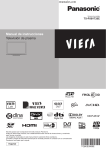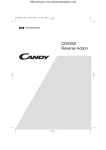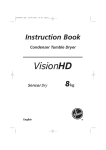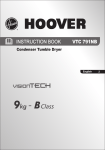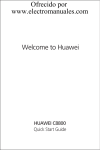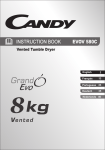Download Candy CC267 Manual - Recambios, accesorios y repuestos
Transcript
Ofrecido por www.electromanuales.com 40003660Eng.qxd 05/08/2005 13:54 Page 1 ® Instruction Book CC2 67 Condenser Tumble Dryer English Español Ofrecido por www.electromanuales.com 40003660Eng.qxd 05/08/2005 13:54 Page 2 English . . . . . . . . . . . . . . . . . . . . . . . . . . . . . . . . . . . . . . . . . . . . 2 Español . . . . . . . . . . . . . . . . . . . . . . . . . . . . . . . . . . . . . . . . . . . 20 Introduction ...............................................3 Delivery information . . . . . . . . . . . . . . . . . . . . . . . . . . . . . . . . . . . . . . . . . . . . . 3 Unpacking the Product . . . . . . . . . . . . . . . . . . . . . . . . . . . . . . . . . . . 3 Safety reminders . . . . . . . . . . . . . . . . . . . . . . . . . . . . . . . . . . . . . . . . . . 4 Installation . . . . . . . . . Use . . . . . . . . . . . . . . . The Laundry . . . . . . . . Environmental Issues . GIAS Service . . . . . . . . . . . . . . . . . . . . . . . . . . . . . . . . . . . . . . . . . . . . . . . . . . . . . . . . . . . . . . . . . . . . . . . . . . . . . . . . . . . . . . . . . . . . . . . . . . . . . . . . . . . . . . . . . . . . . . . . . . . . . . . . . . . . . . . . . . . . . . . . . . . . . . . . . . . . . . . . . . . . . . . . . . . . . . . . . . . . . . . . . . . . . . . . . . . . . . . . . . . . . . . . . . . . . . . . . . . . . . . . . . . . 4 4 4 5 5 Installation . . . . . . . . . . . . . . . . . . . . . . . . . . . . . . . . . . . . . . . . . . . . . . . . . 6 Electrical requirements . . . . . . . . . . . . . . . . . . . . . . . . . . . . . . . . . . . . . . . . . . . 6 Adjusting the feet . . . . . . . . . . . . . . . . . . . . . . . . . . . . . . . . . . . . . . . . . . . . . . . 6 Ventilation . . . . . . . . . . . . . . . . . . . . . . . . . . . . . . . . . . . . . . . . . . . . . . . . . 7 Preparing the load . . . . . . . . . . . . . . . . . . . . . . . . . . . . . . . . . . . . . . . . 8 Clothes preparation . . . . . . . . . . . . . . . . . . . . . . . . . . . . . . . . . . . . . . . . . . . . . . 8 Sorting the load. . . . . . . . . . . . . . . . . . . . . . . . . . . . . . . . . . . . . . . . . . . . . . . . . 9 Drying advice . . . Do not tumble dry . . . . Energy saving. . . . . . . . Drying guide . . . . . . . . . . . . . . . . . . . . . . . . . . . . . . . . . . . . . . . . . . . . . . . . . . . . . . . . . . . . . . . . . . . . . . . . . . . . . . . . . . . . . . . . . . . . . . . . . . . . . . . . . . . . . . . . . . . . . . . . . . . . . . . . . . . . . . . . . . . . . . . . . . . . . . . . . . . . . . . . . . . . . . . . . . . . . . . . 10 10 10 10 Controls and indicators . . . . . . . . . . . . . . . . . . . . . . . . . . . . . . . . . 11 Door and Filter . . . . . . . . . . . . . . . . . . . . . . . . . . . . . . . . . . . . . . . . . . . 12 Opening the door . . . . . . . . . . . . . . . . . . . . . . . . . . . . . . . . . . . . . . . . . . . . . . 12 Filter. . . . . . . . . . . . . . . . . . . . . . . . . . . . . . . . . . . . . . . . . . . . . . . . . . . . . . . . . 12 Filter care indicator . . . . . . . . . . . . . . . . . . . . . . . . . . . . . . . . . . . . . . . . . . . . . 12 Water container . . . . . . . . . . . . . . . . . . . . . . . . . . . . . . . . . . . . . . . . . . 13 To remove the container . . . . . . . . . . . . . . . . . . . . . . . . . . . . . . . . . . . . . . . . . 13 Condenser . . . . . . . . . . . . . . . . . . . . . . . . . . . . . . . . . . . . . . . . . . . . . . . . 14 To remove the condenser . . . . . . . . . . . . . . . . . . . . . . . . . . . . . . . . . . . . . . . . 14 Selecting the Programme . . . . . . . . . . . . . . . . . . . . . . . . . . . . . . . 14 Operation . . . . . . . . . . . . . . . . . . . . . . . . . . . . . . . . . . . . . . . . . . . . . . . . . 16 Cancelling and resetting the programme . . . . . . . . . . . . . . . . . . . . . . . . . . . . 16 Start Delay . . . . . . . . . . . . . . . . . . . . . . . . . . . . . . . . . . . . . . . . . . . . . . . . . . . . 16 Cleaning and Routine Maintenance . . . . . . . . . . . . . . . . . . . . 17 Cleaning the dryer . . . . . . . . . . . . . . . . . . . . . . . . . . . . . . . . . . . . . . . . . . . . . . 17 Technical specifications . . . . . . . . . . . . . . . . . . . . . . . . . . . . . . . . . . . . . . . . . . 17 Troubleshooting . . . . . . . . . . . . . . . . . . . . . . . . . . . . . . . . . . . . . . . . . . 18 Customer Service . . . . . . . . . . . . . . . . . . . . . . . . . . . . . . . . . . . . . . . . . 19 Spares. . . . . . . . . . . . . . . . . . . . . . . . . . . . . . . . . . . . . . . . . . . . . . . . . . . . . . . . 19 GIAS Service . . . . . . . . . . . . . . . . . . . . . . . . . . . . . . . . . . . . . . . . . . . . . . . . . . . 19 2 Ofrecido por www.electromanuales.com 40003660Eng.qxd 05/08/2005 13:54 Page 3 Introduction Please read and follow these instructions carefully and operate the machine accordingly. This booklet provides important guidelines for safe use, installation, maintenance and some useful advice for best results when using your machine. Check that no damage has occurred to the machine during transit. If it has, call for service by GIAS. Keep all documentation in a safe place for future reference or for any future owners Delivery information Please check that the following items are delivered with the appliance: ● Instruction manual ● Guarantee card ● Energy label Failure to comply with the above can compromise the safety of the appliance. You may be charged for a service call if a problem with your machine is caused by misuse. Unpacking the product Remove the machine from its packaging close to the final location of the machine. 1. Cut carefully around the base of the packaging and up one corner. 2. Remove the polythene sleeve and lift the dryer off the polystyrene base. Dispose of the packaging safely. Make sure it is out of the reach of children, it is a potential source of danger. 3 Ofrecido por www.electromanuales.com 40003660Eng.qxd 19/12/2005 14:23 Page 4 Safety reminders Installation ● ● ● ● Check that the product has no visible signs of damage before use. If damaged do not use and please call GIAS Service. Do not use adapters, multiple connectors and/or extensions. This machine should not be installed in a bathroom or shower room. Never install the dryer against curtains and be sure to prevent items from falling or collecting behind the dryer. Use ● ● ● ● ● ● ● ● ● ● ● ● WARNING Misuse of a tumble dryer may create a fire hazard. This machine is solely for domestic use, i.e. to dry household textiles and garments. This machine should only be used for its intended purpose as described in this manual. Ensure that the instructions for installation and use are fully understood before operating the appliance. Do not touch the appliance when hands or feet are damp or wet. Do not lean on the door when loading the machine or use the door to lift or move the machine. Do not allow children to play with the machine or its controls. WARNING Do not use the product if the fluff filter is not in position or is damaged; fluff could be ignited. WARNING Where the hot surface symbol is located the temperature rise during operation of the tumble dryer may be in excess of 60 degrees C. Remove the plug from the electricity supply. Always remove the plug before cleaning the appliance. Do not continue to use this machine if it appears to be faulty. Lint and fluff must not be allowed to collect on the floor around the outside of the machine. The drum inside may be very hot. Always allow the dryer to complete the cool down period before removing the laundry. The Laundry ● ● ● ● 4 WARNING Do not tumble dry fabrics treated with dry cleaning fluids. WARNING Foam rubber materials can, under certain circumstances, when heated become ignited by spontaneous combustion. Foam plastic, foam rubber and rubber-like material are not suitable for tumble drying. Articles made from these materials MUST NOT be placed in the dryer. Always refer to the laundry care labels for directions on suitability for drying. Clothes should be spin dried or thoroughly wrung before they are put into the tumble dryer. Clothes that are dripping wet should NOT be put into the dryer. Ofrecido por www.electromanuales.com 40003660Eng.qxd ● ● ● 19/12/2005 14:24 Page 5 Lighters and matches must not be left in pockets and NEVER use flammable liquids near the machine. Glass fibre curtains should NEVER be put in this machine. Skin irritation may occur if other garments are contaminated with the glass fibres. Garments treated or contaminated with flammable cleaning sprays or liquids such as petrol, cooking oil or aerosol sprays MUST NOT be put in this machine. Environmental Issues ● ● All packaging materials used are environmentally-friendly and recyclable. Please help dispose of the packaging via environmentally-friendly means. Your local council will be able to give you details of current means of disposal. To ensure safety when disposing of an old tumble dryer disconnect the mains plug from the socket, cut the mains power cable and destroy this together with the plug. To prevent children shutting themselves in the machine break the door hinges or the door lock. GIAS Service ● To ensure the continued safe and efficient operation of this appliance we recommend that any servicing or repairs are only carried out by an authorised GIAS Service engineer. European directive 2002/96/EC This appliance is marked according to the European directive 2002/96/EC on Waste Electrical and Electronic Equipment (WEEE). By ensuring this product is disposed of correctly, you will help prevent potential negative consequences for the environment and human health, which could otherwise be caused by inappropriate waste handling of this product. The symbol on the product indicates that this product may not be treated as household waste. Instead it shall be handed over to the applicable collection point for the recycling of electrical and electronic equipment Disposal must be carried out in accordance with local environmental regulations for waste disposal. For more detailed information about treatment, recovery and recycling of this product, please contact your local city office, your household waste disposal service or the shop where you purchased the product. If the appliance is not running properly or breaks down, switch it off and disconnect the plug from the socket. Consult GIAS Service for possible repair. 5 Ofrecido por www.electromanuales.com 40003660Eng.qxd 05/08/2005 13:54 Page 6 Installation You may be charged for a service call if a problem with your machine is caused by incorrect installation. Electrical requirements Tumble dryers are supplied to operate at a voltage of 230V, 50 Hz single phase. Check that the supply circuit is rated to at least 16A. Electricity can be extremely dangerous. This appliance must be earthed. The socket outlet and the plug on the appliance must be of the same type. Do not use multiple adapters and/or extension leads. If the mains cord on this appliance is damaged, it must be replaced by a special cord which is ONLY obtainable from the spares service. It must be installed by a competent person. The plug should be accessible for disconnection after the appliance has been installed. The wires in the mains lead are coloured in accordance with the following codes: Blue NEUTRAL Brown LIVE Green and Yellow EARTH CE Appliance complies with European Directive 89/336/EEC, 73/23/EEC and subsequent amendments. Do not plug the machine in and switch it on at the mains until the installation is completed. For your safety, this dryer must be correctly installed. If there is any doubt about installation, call GIAS Service for advice. Adjusting the feet Once the machine is in place the feet should be adjusted to ensure that the machine is level. Adjust the four feet to ensure the machine is firm and level. 6 Ofrecido por www.electromanuales.com 40003660Eng.qxd 05/08/2005 13:54 Page 7 Ventilation Adequate ventilation must be provided in the room where the tumble dryer is located to prevent gases from appliances burning other fuels, including open fires, being drawn into the room during operation of the tumble dryer. ● Exhaust air must not be discharged into a flue which is used for exhausting fumes from appliances burning gas or other fuels. ● Check regularly that the air flowing through the dryer is not restricted. ● Check the fluff filter after use, and clean, if necessary. ● The inlet and outlets should be kept free from obstructions. To ensure adequate ventilation the space between the bottom of the machine and the floor must not be obstructed. There should be a gap of at least 12mm between the machine and any obstructions. ● Prevent items from falling or collecting behind the dryer as these may obstruct the air inlet and outlet. ● NEVER install the dryer up against curtains. AIR INLET VENTS AIR OUTLETS AIR OUTLETS IN THE BASE 7 Ofrecido por www.electromanuales.com 40003660Eng.qxd 05/08/2005 13:54 Page 8 Preparing the load Before using the tumble dryer for the first time: ● Please read this instruction book thoroughly. ● Remove all items packed inside drum. ● Wipe the inside of the drum and door with a damp cloth to remove any dust which may have settled in transit. Clothes preparation Make sure that the laundry you are going to dry is suitable for drying in a tumble dryer, as shown by the care symbols on each item. Do not overload the drum, large items when wet can exceed the maximum admissible clothes load (for example: sleeping bags, duvets). 8 Check that all fastenings are closed and that pockets are empty. Turn the articles inside out. Place clothes loosely in the drum to make sure that they don't get tangled. Maximum drying weight ● Cottons Max. 7.5 kg ● Synthetics Max. 3.5 kg Ofrecido por www.electromanuales.com 40003660Eng.qxd 05/08/2005 13:54 Page 9 Sort the load as follows: ● By care symbols These can be found on the collar or inside seam: Suitable for tumble drying. Tumble drying at high temperature. Tumble drying at low temperature only. Do not tumble dry. If the item does not have a care label it must be assumed that it is not suitable for tumble drying. ● By amount and thickness Whenever the load is bigger than the dryer capacity, separate clothes according to thickness (e.g. towels from thin underwear). ● By type of fabric Cottons/linen: Towels, cotton jersey, bed and table linen. Synthetics: Blouses, shirts, overalls, etc. made of polyester or polyamid, as well as for cotton/synthetic mixes. ● By drying level Sort into: iron dry, cupboard dry, etc. For delicate articles press the Delicados Sintéticos button to select low drying temperature. 9 Ofrecido por www.electromanuales.com 40003660Eng.qxd 05/08/2005 13:54 Page 10 Drying advice IMPORTANT: Do not dry articles which have been treated with a dry cleaning fluid or rubber clothes (danger of fire or explosion). During the last 15 minutes the load is always tumbled in cool air. Do not tumble dry: Woollens, silk, delicate fabrics, nylon stockings, delicate embroidery, fabrics with metallic decorations, garments with PVC or leather trimmings, training shoes, bulky items such as sleeping bags, etc. Energy saving Only put into the tumble dryer laundry which has been thoroughly wrung or spin-dried. The drier the laundry the shorter the drying time thus saving electricity. ALWAYS ● Try to dry the maximum weight of laundry, this will save time and electricity. ● Check that the filter is clean before every drying cycle. NEVER ● Exceed the maximum weight, this will waste time and electricity. ● Put dripping wet items into the tumble dryer, this may damage the appliance. Drying guide The table shows approximate drying times, depending on the type of fabric and dampness of the clothes. Fabric HEAT SETTING HEAVY LOAD MEDIUM LOAD LIGHT LOAD COTTON HIGH 140-165 min 70-80 min 50-65 min SYNTHETICS LOW – 70-80 min 40-55 min ACRYLIC LOW – 50-65 min 30-40 min 10 Ofrecido por www.electromanuales.com 40003660Eng.qxd 05/08/2005 13:54 Page 11 Controls and indicators COUNTDOWN DISPLAY (TIEMPO RESTANTE) FILTER CARE INDICATOR (FILTRO) ON/OFF BUTTON EMPTY WATER START ACRYLICS/ PROGRAMME START DELAY INDICATOR SYNTHETICS BUTTON BUTTON SELECTOR BUTTON (DEPOSITO (DELICADOS (INICIO DIFERIDO) LLENO) SINTETICOS) Control panel and indicator lights Programme Selector – Select the required programme On/Off button and indicator – Press to switch on, the indicator will light START – Press START to commence the selected drying programme. Press for 5 seconds to cancel/reset the programme Acrylics/Synthetics button (Delicados Sintéticos) – Press to reduce the heat level for delicate items, the indicator above the button will light up. To change the heat setting the programme must be reset Low Heat – Indicator light ON High Heat – Indicator light OFF Empty Water indicator (Deposito Lleno) – lights when the water container is full Filter Care indicator (Filtro) – lights when the filter needs cleaning Start Delay button (Inicio Diferido) – Allows the user to delay the start of the drying cycle (see details of operation page 16) Tiempo Restante Display START – When the dryer is switched On the START indicator will flash, when the programme starts the START indicator will light up 60' – Indicator lights when there is less than 60 minutes left until completion of the programme 15' - Indicator lights when there is less than 15 minutes left until completion of the programme. At this stage of the drying cycle the machine enters the Cool Down phase STOP - Indicator lights when the programme is finished. 6h - 6 hour start delay (light flashes when in operation) 9h - 9 hour start delay (light flashes when in operation) 11 Ofrecido por www.electromanuales.com 40003660Eng.qxd 05/08/2005 13:54 Page 12 Door and Filter Opening the door Pull on handle to open the door. To restart the dryer, close the door and press Start. WARNING! When the tumble dryer is in use the drum and door may be VERY HOT. Filter IMPORTANT: To maintain the efficiency of the dryer check that the fluff filter is clean before each drying cycle. 1. Pull the filter upwards. 2. Open filter as shown. 3. Gently remove lint using a soft brush or your fingertips. 4. Snap the filter together and push back into place. Filter Care Indicator “Filtro” lights when the filter needs cleaning. If the laundry is not drying check that the filter is not clogged. 12 Ofrecido por www.electromanuales.com 40003660Eng.qxd 05/08/2005 13:54 Page 13 Water Container The water removed from the laundry during the drying cycle is collected in a container at the bottom of the dryer. When the container is full the Deposito Lleno indicator on the control panel will light, and the container MUST be emptied. However, we recommend that the container is emptied after each drying cycle. NOTE: Very little water will collect during the first few cycles of a new machine as an internal reservoir is filled first. To remove the container 1. Gently pull the bottom of the kickplate so that it unclips from the dryer. The top section can then be unhinged allowing the kickplate to be completely removed. 2. Pull firmly on the handgrip and slide the water container out of the dryer. Support the container with both hands. When full, the water container will weigh about 4kg. 3. Open the lid located on the top of the container and empty the water. 4. Refit the lid and slide the water container back into position. PUSH FIRMLY INTO PLACE. 5. Refit the kickplate by engaging the hinges at the top and 'snapping' the lower clips into place. 13 Ofrecido por www.electromanuales.com 40003660Eng.qxd 05/08/2005 13:54 Page 14 Condenser Important: Always switch off and remove the plug from the electricity supply before cleaning the condenser. To maintain the efficiency of the dryer regularly check that the condenser is clean. To remove the condenser 1. Remove the kickplate (see page 13). 2. Turn the two locking levers anti-clockwise and pull out the condenser. 3. Pull out the condenser unit. 4. Gently remove any dust or fluff with a cloth, then wash the unit by holding it under a running tap turning it so that water flows between the plates, to remove any dust or fluff. 5. Refit the condenser ensuring it is in the correct way (as indicated by the arrow) and pushed firmly into place. Lock the two levers by turning them clockwise. 6. Refit the kickplate. Selecting the Programme The Sensor Dry machine gives many options for drying the laundry to suit all circumstances. Note: The sensor may not detect a small load of small articles. For small loads and separate items or pre-dried fabrics with low moisture content, use the timed programmes. Set the 14 Ofrecido por www.electromanuales.com 40003660Eng.qxd 05/08/2005 13:54 Page 15 programme between 30 and 75 minutes depending on the load size and dryness required, and select high or low heat depending upon the fabric type. If the sensor does not detect the item the dryer will only operate for 10 minutes before going into cooldown. If the load is too large or too wet to tumble dry the dryer will automatically go into cooldown after 180 minutes. The table below lists the programmes and the function of each programme. Programme Description Bone Dry Select the degree of dryness that you require. This ranges from Bone Dry for bath towels and bathrobes, through Cupboard Dry for items that will be put away without ironing, to the programme that leaves the laundry suitable for ironing. Extra Dry Cupboard Dry Iron Dry Wool A gentle programme specially created to get woollens softer after air-drying. This delicate warm air cycle, lasting 12 minutes, can also be used to get woollens 'refreshed' after being stored in the wardrobe. Fast Iron The Fast Iron programme provides a conditioning and anticrease function. The dryer will heat the load for 9 minutes followed by a 3 minute cool down period and is especially good for garments which may have been left for some time prior to ironing, in a linen basket for example. Garments may also become stiffened when dried outside on a washing line or inside on radiators. The Fast Iron process relaxes the creases in the fabric making ironing quicker and easier. 120' 120 minutes of drying 75' 75 minutes of drying 60' 60 minutes of drying 45' 45 minutes of drying 30' 30 minutes of drying Refresh Tumbling of laundry in cool air 15 Ofrecido por www.electromanuales.com 40003660Eng.qxd 05/08/2005 13:54 Page 16 Operation 1. Open the door and load the drum with laundry. Ensure that garments do not hinder closure of the door. 2. Gently close the door pushing it slowly until you hear the door 'click' shut. 3. Press the On/Off button to switch on the dryer. The indicator will light up and the START indicator will flash. 4. Turn the Programme Selector dial to select the required drying program (see Programme Guide). 5. If drying synthetics, acrylics or delicate items, press the Delicados Sintéticos button to reduce the heat level. The light above the push button will light up when the machine is in low heat setting. To deselect this status when the drying cycle has started it is necessary to reset the machine. 6. Press the Start button. The dryer will start automatically and the START indicator will be continuously lit. 7. The Inicio Diferido display will show the drying progress in terms of time remaining. 8. If the door is opened during the programme to check the laundry, it is necessary to press Start to recommence drying after the door has been closed. 9. When the 15' indicator is lit the machine will enter the cool down phase, the clothes will be tumbled in cool air allowing the load to cool down. 10. When the programme is complete the STOP indicator will light. Cancelling and resetting the programme To cancel a programme press the START button for 5 seconds. The machine will indicate that it has been reset by the START indicator flashing. It is possible to change the programme within the first 10 minutes without using the cancel and reset function. Start Delay The Delay Start Function (Inicio Diferido) allows the user to delay the start of the drying cycle by 6 or 9 hours. When the function is first selected the display will show a delay of 6 hours, a subsequent press of the button will increase the delay to 9 hours. 16 Ofrecido por www.electromanuales.com 40003660Eng.qxd 05/08/2005 13:54 Page 17 To commence the programme press Start and the appliance will complete the drying cycle at the end of this time. The 6 or 9 hour indicator light will flash to indicate that the start delay is in progress. WARNING! The drum, door and load may be very hot. Cleaning and Routine Maintenance Cleaning the dryer ● Clean the filter and empty the water container after every drying cycle. ● Regularly clean the condenser. ● After each period of use, wipe the inside of the drum and leave the door open for a while to allow circulation of air to dry it. ● Wipe the outside of the machine and the door with a soft cloth. ● DO NOT use abrasive pads or cleaning agents. ● To prevent the door sticking or the build up of fluff periodically clean the inner door and gasket with a damp cloth. IMPORTANT Always switch off and remove the plug from the electricity supply before cleaning this appliance. Technical specifications Drum capacity 115 litres Maximum load 7.5 kg Height 85cm Width 60cm Depth 60cm Energy Label Band C For electrical data refer to the rating label on the front of the dryer cabinet (with the door open). 17 Ofrecido por www.electromanuales.com 40003660Eng.qxd 05/08/2005 13:54 Page 18 Troubleshooting What might be the cause of... Defects you can remedy yourself Before calling GIAS Service for technical advice please run through the following checklist. A charge will be made if the machine is found to be working or has been installed incorrectly or used incorrectly. If the problem persists after completing the recommended checks, please call GIAS Service, they may be able to assist you over the telephone. Drying time is too long/clothes are not dry enough… ● ● ● ● ● ● ● Have you selected the correct drying time/programme? Were the clothes too wet? Were the clothes thoroughly wrung or spindried? Does the filter need cleaning? Does the condenser need cleaning? Is the dryer overloaded? Are the inlets, outlets and base of the dryer free from obstructions? Has the Delicados Sintéticos option been selected from a previous cycle? The dryer does not operate… ● ● ● ● ● ● ● ● ● Is there a working electricity supply to the dryer? Check using another appliance such as a table lamp. Is the plug properly connected to the mains supply? Is there a power failure? Has the fuse blown? Is the door fully closed? Is the dryer switched on, both at the mains supply and at the machine? Has the drying time or the programme been selected? Has the machine been switched on again after opening the door? Has the dryer stopped operating because the water tray is full and needs emptying? The dryer is noisy… ● Switch off the dryer and contact GIAS Service for advice. The Filter Care Indicator is on… ● ● Does the filter need cleaning? Does the condenser need cleaning? Empty Water Indicator is on… ● 18 Does the water container need emptying? Ofrecido por www.electromanuales.com 40003660Eng.qxd 05/08/2005 13:54 Page 19 Customer Service Should there still be a problem with your dryer after completing all the recommended checks, please call GIAS Service for advice. They may be able to assist you over the telephone or arrange for a suitable appointment for an engineer to call under the terms of your guarantee. However, a charge may be made if any of the following applies to your machine: ● Is found to be in working order. ● Has not been installed in accordance with the installation instructions. ● Has been used incorrectly. Spares Always use genuine spares, available direct from GIAS Service. GIAS Service For service and repairs call your local GIAS Service engineer. The manufacturer declines all responsibility in the event of any printing mistakes in this booklet. The manufacturer also reserves the right to make appropriate modifications to its products without changing the essential characteristics. 19 Ofrecido por www.electromanuales.com 40003660Spa.qxd 05/08/2005 13:51 Page 20 Introducción . . . . . . . . . . . . . . . . . . . . . . . . . . . . . . . . . . . . . . . . . . . . . . 21 Información de entrega . . . . . . . . . . . . . . . . . . . . . . . . . . . . . . . . . . . . . . . . . . 21 Desembalaje del producto . . . . . . . . . . . . . . . . . . . . . . . . . . . . . . 21 Advertencias sobre seguridad . . . . . . . . . . . . . . . . . . . . . . . . . . 22 Instalación . . . . . . . . . . . . Uso . . . . . . . . . . . . . . . . . . La colada . . . . . . . . . . . . . Temas medioambientales. Servicio técnico de GIAS. . . . . . . . . . . . . . . . . . . . . . . . . . . . . . . . . . . . . . . . . . . . . . . . . . . . . . . . . . . . . . . . . . . . . . . . . . . . . . . . . . . . . . . . . . . . . . . . . . . . . . . . . . . . . . . . . . . . . . . . . . . . . . . . . . . . . . . . . . . . . . . . . . . . . . . . . . . . . . . . . . . . . . . . . . . . . . . . . . . . . . . . . . . . . . . . . . . . . . . . . . 22 22 22 23 23 Instalación . . . . . . . . . . . . . . . . . . . . . . . . . . . . . . . . . . . . . . . . . . . . . . . . 24 Requisitos eléctricos . . . . . . . . . . . . . . . . . . . . . . . . . . . . . . . . . . . . . . . . . . . . . 24 Ajuste de las patas . . . . . . . . . . . . . . . . . . . . . . . . . . . . . . . . . . . . . . . . . . . . . . 24 Ventilación . . . . . . . . . . . . . . . . . . . . . . . . . . . . . . . . . . . . . . . . . . . . . . . . 25 Preparación del material para secar . . . . . . . . . . . . . . . . . . . . 26 Preparación de la ropa. . . . . . . . . . . . . . . . . . . . . . . . . . . . . . . . . . . . . . . . . . . 26 Clasificación del material para secar . . . . . . . . . . . . . . . . . . . . . . . . . . . . . . . . 27 Consejos para el secado . . . . . . . . . . . . . . . . . . . . . . . . . . . . . . . . . 28 No secar en secadora . . . . . . . . . . . . . . . . . . . . . . . . . . . . . . . . . . . . . . . . . . . . 28 Ahorro de energía . . . . . . . . . . . . . . . . . . . . . . . . . . . . . . . . . . . . . . . . . . . . . . 28 Guía de secado. . . . . . . . . . . . . . . . . . . . . . . . . . . . . . . . . . . . . . . . . . . . . . . . . 28 Controles e indicadores . . . . . . . . . . . . . . . . . . . . . . . . . . . . . . . . . 29 Puerta y filtro. . . . . . . . . . . . . . . . . . . . . . . . . . . . . . . . . . . . . . . . . . . . . 30 Modo de abrir la puerta . . . . . . . . . . . . . . . . . . . . . . . . . . . . . . . . . . . . . . . . . 30 Filtro. . . . . . . . . . . . . . . . . . . . . . . . . . . . . . . . . . . . . . . . . . . . . . . . . . . . . . . . . 30 Control de mantenimiento del filtro . . . . . . . . . . . . . . . . . . . . . . . . . . . . . . . . 30 Depósito del agua . . . . . . . . . . . . . . . . . . . . . . . . . . . . . . . . . . . . . . . 31 Modo de sacar el recipiente . . . . . . . . . . . . . . . . . . . . . . . . . . . . . . . . . . . . . . 31 Condensador . . . . . . . . . . . . . . . . . . . . . . . . . . . . . . . . . . . . . . . . . . . . . 32 Modo de sacar el condensador . . . . . . . . . . . . . . . . . . . . . . . . . . . . . . . . . . . . 32 Selección del programa. . . . . . . . . . . . . . . . . . . . . . . . . . . . . . . . . . 32 Operación . . . . . . . . . . . . . . . . . . . . . . . . . . . . . . . . . . . . . . . . . . . . . . . . . 34 Modo de cancelar y restablecer el programa . . . . . . . . . . . . . . . . . . . . . . . . . 34 Inicio diferido. . . . . . . . . . . . . . . . . . . . . . . . . . . . . . . . . . . . . . . . . . . . . . . . . . 34 Limpieza y mantenimiento de rutina . . . . . . . . . . . . . . . . . . 35 Limpieza de la secadora. . . . . . . . . . . . . . . . . . . . . . . . . . . . . . . . . . . . . . . . . . 35 Especificaciones técnicas . . . . . . . . . . . . . . . . . . . . . . . . . . . . . . . . . . . . . . . . . 35 Resolución de problemas . . . . . . . . . . . . . . . . . . . . . . . . . . . . . . . . 36 Servicio de atención al cliente . . . . . . . . . . . . . . . . . . . . . . . . . . 37 Servicio de recambios. . . . . . . . . . . . . . . . . . . . . . . . . . . . . . . . . . . . . . . . . . . . 37 Servicio técnico de GIAS. . . . . . . . . . . . . . . . . . . . . . . . . . . . . . . . . . . . . . . . . . 37 20 Ofrecido por www.electromanuales.com 40003660Spa.qxd 05/08/2005 13:51 Page 21 Introducción Por favor lea cuidadosamente estas instrucciones y utilice la máquina según sus indicaciones. Este folleto presenta directrices importantes para uso seguro, instalación y mantenimiento, y algunos consejos para obtener los mejores resultados de su secadora. Conserve toda la documentación en un lugar seguro para referencia futura o para los dueños futuros Información de entrega Por favor verifique que los siguientes artículos hayan sido entregados con el electrodoméstico: ● Manual de instrucciones ● Tarjeta de garantía ● Etiqueta de energía Verifique que no se hayan producido daños al electrodoméstico durante el transporte. De haberlos, llame al Servicio técnico de GIAS. Si no se cumplen los requisitos descritos anteriormente, es posible que se perjudique la seguridad del electrodoméstico. Es posible que se le cobre una llamada al servicio técnico si el problema con el electrodoméstico es el resultado de un uso incorrecto. Desembalaje del producto Desembale la secadora en un lugar cercano al de su instalación definitiva. 1. Corte con cuidado la base del embalaje y levante una de las esquinas. 2. Retire la funda de plástico y saque la secadora de la base de poliestireno. Deshágase de los materiales de embalaje de forma segura. Asegúrese de que estén fuera del alcance de los niños, dado que es una fuente potencial de peligro. 21 Ofrecido por www.electromanuales.com 40003660Spa.qxd 19/12/2005 14:31 Page 22 Advertencias sobre seguridad Instalación ● ● ● ● Verifique que el producto no tenga daños visibles antes de usarlo. En caso de presentar algún daño, no lo use y póngase en contacto con el Servicio técnico de GIAS. No utilice adaptadores, conectores múltiples ni alargaderas. No se debe instalar esta máquina en un cuarto de baño ni en una sala de ducha. Nunca instale la secadora junto a cortinas, y procure que no caigan objetos ni se acumule nada detrás de la secadora. Uso ● ● ● ● ● ● ● ● ● ● ● ● ADVERTENCIA El uso incorrecto de una secadora puede provocar riesgo de incendio. Esta máquina está diseñada para ser utilizada en el hogar, es decir, para secar tejidos y prendas de uso diario. Esta máquina debe usarse solamente para el propósito para el cual fue diseñada. Las instrucciones para la instalación y el uso deben comprenderse cabalmente antes de hacer funcionar el electrodoméstico. No toque el electrodoméstico cuando tenga las manos o los pies mojados o húmedos. No se apoye en la puerta al cargar la secadora ni utilice la puerta para levantar o mover la máquina. No permita a los niños jugar con la máquina ni los mandos. ADVERTENCIA No use el producto si el filtro de pelusa no está en su lugar o si está dañado, ya que la pelusa podría arder. ADVERTENCIA En el lugar donde aparezca el símbolo de superficie caliente , el incremento de temperatura durante la operación de la secadora puede exceder los 60 grados centígrados. Desconecte el enchufe de la red del suministro eléctrico. Siempre debe desenchufar la máquina antes de limpiarla. No siga usando esta máquina si pareciera tener algún desperfecto. No hay que dejar que se acumulen lanilla y pelusas en el suelo alrededor de la máquina. El tambor del interior puede calentarse mucho. Antes de retirar la ropa de la máquina, siempre deje que ésta termine de enfriarse. La colada ● ● ● ● 22 ADVERTENCIA No debe usarse para secar tejidos tratados con líquidos para limpiado en seco. ADVERTENCIA Los materiales de goma de espuma, en algunas circunstancias, pueden arder por combustión espontánea si se calientan. Espuma plástica, goma de espuma, y materiales semejantes a la goma no son apropiados para secarse en secadora. NO HAY QUE introducir en la secadora piezas hechas de estos materiales. Consulte siempre las etiquetas sobre lavado de las prendas para conocer si se pueden secar en secadora. Antes de introducir ropa en la secadora, aquélla debe centrifugarse o estrujarse Ofrecido por www.electromanuales.com 40003660Spa.qxd ● ● ● 19/12/2005 14:32 Page 23 bien. Prendas que escurren agua NO deben introducirse en la secadora. Deben sacarse de los bolsillos encendedores y cerillas, y no se debe NUNCA usar líquidos inflamables cerca de la máquina. No se debe NUNCA introducir cortinas de fibra de vidrio en esta máquina. Puede producirse irritación de la piel si otras prendas se contaminan con fibras de vidrio. Las prendas tratadas o contaminadas con productos de limpieza inflamables o líquidos tales como gasolina, aceite para cocinar o aerosoles NO DEBEN colocarse en esta máquina. Temas medioambientales ● ● Todos los materiales de embalaje utilizados son ecológicos y reciclables. Por favor deshágase de los materiales de embalaje por medios ecológicos. Su ayuntamiento podrá informarle de los medios actuales de desecho. Por razones de seguridad cuando se deseche una secadora, desenchufe el cable eléctrico de la toma general, corte el cable y destrúyalo junto con el enchufe. Para evitar que los niños se queden encerrados en la máquina, rompa las bisagras o la cerradura de la puerta. Servicio técnico de GIAS ● Para que esta máquina siga funcionando de modo seguro y eficiente, recomendamos que todo mantenimiento o reparación sea efectuado únicamente por un ingeniero autorizado de mantenimiento GIAS. Directiva europea 2002/96/EC Este electrodoméstico está marcado conforme a la directiva Europea 2002/96/CE sobre los residuos de aparatos eléctricos y electrónicos (WEEE). Asegurándose que este producto ha sido eliminado correctamente, ayudará a evitar posibles consecuencias negativas en el ambiente y la salud de las personas, que pudiera verificarse por causa de un anómalo tratamiento de este producto. El símbolo sobre el producto indica que este aparato no puede ser tratado como un residuo doméstico normal, en su lugar deberá ser entregado al centro de recogidas para reciclaje de aparatos eléctricos y electrónicos. La eliminación debe ser efectuada de acuerdo con las reglas medioambientales vigentes para el tratamiento de los residuos. Para información más detallada sobre el tratamiento, recuperación y reciclaje de este producto, por favor contacte con la oficina competente (del departamento de ecología y medioambiente), o su servicio de recogida a domicilio si lo hubiera o el punto de venta donde compró el producto. Si el electrodoméstico no funciona correctamente o se avería, apáguelo y desconecte el enchufe de la toma de corriente. Consulte al Servicio técnico de GIAS para la posible reparación. 23 Ofrecido por www.electromanuales.com 40003660Spa.qxd 05/08/2005 13:51 Page 24 Instalación Es posible que se le cobre una llamada al servicio técnico si el problema con el electrodoméstico es el resultado de una instalación incorrecta. Requisitos eléctricos Las secadoras están preparadas para funcionar con un voltaje monofásico de 230 V, a 50 Hz. Verifique que el circuito de suministro tenga una corriente nominal de al menos 16 A. La electricidad puede ser muy peligrosa. Es imprescindible que esta máquina tenga conexión a tierra. La toma de corriente y el enchufe del electrodoméstico deben ser del mismo tipo. No utilice adaptadores múltiples ni alargaderas. Si se dañara el cable eléctrico de esta máquina, debe reemplazarse con un cable especial que se puede obtener ÚNICAMENTE del Servicio de recambios. Una persona capacitada debe encargarse de la instalación. Después de haberse instalado la máquina, el enchufe debe quedar en una posición fácil de alcanzar en el momento de desconectarlo. Los conductores del cable de conexión eléctrica son de diferentes colores, según la codificación siguiente: Azul NEUTRO Marrón CON CORRIENTE Verde y amarillo CONEXIÓN A TIERRA Este electrodoméstico CE cumple la Directiva europea 89/336/EEC, 73/23/EEC y sus enmiendas subsiguientes. No enchufe el electrodoméstico ni lo encienda conectado a la red eléctrica hasta que se haya completado la instalación. Para su protección, hay que instalar esta secadora correctamente. En caso de alguna duda acerca de la instalación, llame al Servicio GIAS de Atención al Cliente para obtener información. Ajuste de las patas Una vez que la máquina esté en su sitio, las patas deben ajustarse para asegurarse de que esté nivelada. Ajuste las cuatro patas para garantizar que la máquina esté firme y nivelada. 24 Ofrecido por www.electromanuales.com 40003660Spa.qxd 05/08/2005 13:51 Page 25 Ventilación Debe suministrarse ventilación adecuada en la sala donde esté ubicada la secadora para evitar que los gases de aparatos que quemen otros combustibles, incluyendo llamas abiertas, ingresen en la sala cuando se está usando la secadora. ● El aire extraído no debe descargarse dentro de un conducto que sea utilizado para expulsar humos de aparatos que quemen gas u otros combustibles. ● Compruebe periódicamente que no esté obstruido el paso de la corriente de aire a través de la secadora. ● Después de usar la máquina, revise el filtro de polvo y límpielo si es necesario. ● Las tomas y salidas de aire deben mantenerse libres de todo obstáculo. Para que haya suficiente ventilación, no debe haber ningún obstáculo en el espacio que se encuentra entre el fondo de la máquina y el suelo. Debería haber una separación de por lo menos 12 mm entre la máquina y cualquier obstáculo. ● Procure que no caigan objetos ni se acumulen detrás de la máquina, ya que éstos pueden tapar la entrada y salida de aire. ● NUNCA instale la secadora junto a cortinas. TOMAS DE AIRE SALIDAS DE AIRE SALIDAS DE AIRE EN LA BASE 25 Ofrecido por www.electromanuales.com 40003660Spa.qxd 05/08/2005 13:51 Page 26 Preparación del material para secar Antes de usar por primera vez la secadora: No cargue el tambor en exceso; los artículos grandes, al humedecerse, pueden superar la carga de ropa máxima admisible (por ejemplo: sacos de dormir, edredones). 26 ● Por favor lea con atención las instrucciones de este manual. ● Retire todos los artículos que haya guardado en el interior del tambor. ● Con un trapo húmedo, limpie el interior del tambor y de la puerta para quitar el polvo que pueda haberse depositado durante el traslado. Preparación de la ropa Compruebe que los artículos que propone secar sean apropiados para secadora, de acuerdo a los símbolos sobre cuidado que lleve cada artículo. Compruebe que todos los cierres estén cerrados, y que no quede nada en los bolsillos. Ponga los artículos al revés. Coloque la ropa en el tambor, sin presionarla, para asegurar que no se enrede. Peso máximo del material ● Piezas de algodón máx. 7,5 kg ● Piezas de fibras sintéticas máx. 3,5 kg Ofrecido por www.electromanuales.com 40003660Spa.qxd 05/08/2005 13:51 Page 27 Clasifique los artículos que se van a secar de la siguiente manera: ● Según los símbolos de cuidado Se encuentran en el cuello o en la costura interior: Apropiado para secadora. Usar secadora a alta temperatura. Usar secadora solamente a baja temperatura. No secar en secadora. Si el artículo no tiene etiqueta de lavado, se debe presuponer que no es apropiado para secadora. ● Según la cantidad y el grosor Cuando la cantidad del material para secar sea mayor que la capacidad de la secadora, separe la ropa de acuerdo a su espesor (por ej. separe las toallas de la ropa interior delgada). ● Según el tipo de tela Algodón/hilo: Toallas, jerseys de algodón, ropa de cama y mantelería. Fibras sintéticas: Blusas, camisas, monos, etc. hechos de poliéster o poliamida, y también para mezclas de algodón/fibras sintéticas. ● Según el grado de secado Clasificar los artículos según como tienen que quedar: listos para planchar, listos para guardar, etc. Para prendas delicadas, presione el botón Delicados Sintéticos para seleccionar una temperatura más baja de secado. 27 Ofrecido por www.electromanuales.com 40003660Spa.qxd 05/08/2005 13:51 Page 28 Consejos para el secado IMPORTANTE: No usar la secadora para artículos que se hayan tratado con líquidos para limpiado en seco ni para prendas de goma (peligro de incendio o de explosión). Durante los últimos 15 minutos, las piezas siempre giran en aire frío. No secar en secadora: Prendas de lana, seda, telas delicadas, medias de nylon, bordados delicados, tela con adornos metálicos, prendas con guarniciones de PVC o de cuero, zapatillas de deporte, piezas voluminosas como sacos de dormir, etc. Ahorro de energía Se deben poner en la secadora solamente artículos que se hayan estrujado bien o que se hayan centrifugado para quitar el agua. A menos humedad que tengan las prendas que se han de secar, más corto será el tiempo de secado, lo cual ahorrará energía eléctrica. SIEMPRE ● Procure secar el máximo peso permitido de artículos, para economizar tiempo y energía. ● Compruebe que el filtro esté limpio antes de iniciar el ciclo de secado. NUNCA ● Debe excederse del peso máximo, porque de hacerlo así se malgasta tiempo y energía eléctrica. ● Introduzca en la secadora artículos que chorreen agua, porque se puede dañar el aparato. Guía de secado En la tabla se señala el tiempo aproximado de secado, según el tipo de tela y la humedad de la ropa. Tejido TEMPERATURA SELECCIONADA PESADO MEDIANO LIGERO ALGODÓN ALTA 140-165 Mín 70-80 Mín 50-65 Mín FIBRAS SINTÉTICAS BAJA – 70-80 Mín 40-55 Mín FIBRAS ACRÍLICAS BAJA – 50-65 Mín 30-40 Mín 28 Ofrecido por www.electromanuales.com 40003660Spa.qxd 05/08/2005 13:51 Page 29 Controles e indicadores PANTALLA TIEMPO RESTANTE INDICADOR DEPÓSITO LLENO INDICADOR DE CUIDADO DE FILTRO BOTÓN DELICADOS SINTÉTICOS BOTÓN START (INICIO) BOTÓN ON/OFF (MARCHA/PARADA) BOTÓN INICIO DIFERIDO SELECTOR DE PROGRAMA Panel de control y luces de aviso Selector de programa – Seleccione el programa requerido. Botón On/Off (Marcha/Parada) e indicador – Presiónelo para activar la máquina y se iluminará el indicador. Botón Start (INICIO) – presione Start para comenzar el programa de secado seleccionado. Presione durante 5 segundos para cancelar/restablecer el programa. Botón Delicados Sintéticos (Fibras acrílicas/sintéticas) – Presiónelo para bajar la temperatura para prendas delicadas; se iluminará el indicador de encima del botón. Para cambiar la temperatura seleccionada, el programa se debe restablecer. Calor suave: indicador ENCENDIDO Calor intenso: indicador APAGADO. Indicador ‘Depósito Lleno’ – se ilumina cuando está lleno el depósito del agua. Indicador de cuidado de filtro (Filtro) – se enciende cuando el filtro debe limpiarse. Botón de Inicio Diferido – Permite al usuario retrasar el inicio del ciclo de secado (consulte los detalles de Operación en la página 34). Pantalla Tiempo Restante START – Cuando la secadora está encendida, el indicador START parpadea; cuando comienza el programa, el indicador START se enciende. 60' – el indicador se enciende cuando quedan menos de 60 minutos hasta el final del programa. 15' – el indicador se enciende cuando quedan menos de 15 minutos hasta el final del programa. En esta etapa del ciclo de secado, la máquina entra en la fase de enfriamiento. STOP – el indicador se enciende cuando termina el programa. 6h – inicio diferido de 6 horas (la luz parpadea cuando está en funcionamiento). 9h – inicio diferido de 9 horas (la luz parpadea cuando está en funcionamiento). 29 Ofrecido por www.electromanuales.com 40003660Spa.qxd 05/08/2005 13:51 Page 30 Puerta y filtro Modo de abrir la puerta Tire de la palanca para abrir la puerta. Para poner la secadora en marcha nuevamente, cierre la puerta y presione Start. ¡AVISO! Cuando la secadora está en uso, puede que el tambor y la puerta SE CALIENTEN MUCHO. Filtro IMPORTANTE: Para mantener la secadora en condiciones de funcionamiento eficiente, compruebe que el filtro de polvo esté limpio antes de cada ciclo de secado. 1. Tire del filtro hacia arriba. 2. Abra el filtro de la manera señalada. 3. Saque las pelusas usando un cepillo suave o con la punta de los dedos. 4. Rearme el filtro, acoplándolo con un golpe seco, y empújelo nuevamente a su sitio. El control de mantenimiento del filtro “Filtro” se ilumina cuando hay que limpiar el filtro. Si las piezas para secar no se secan, verifique que no se haya tapado el filtro. 30 Ofrecido por www.electromanuales.com 40003660Spa.qxd 05/08/2005 13:51 Page 31 Depósito del agua El agua que se saca de la ropa durante el ciclo de secado se recoge en un recipiente que se encuentra en el fondo de la secadora. Cuando el depósito está lleno, se ilumina el indicador Depósito Lleno del panel de control, y, SIN FALTA, hay que vaciar el depósito. Sin embargo, recomendamos vaciar el recipiente después de cada ciclo de secado. NOTA: Durante los primeros ciclos de una máquina nueva se amontonará muy poca agua, ya que primero se llena un tanque interno. Modo de sacar el recipiente 1. Tire cuidadosamente de la parte inferior del protector para desengancharlo de la secadora. A continuación se puede abrir la parte superior, permitiendo sacar completamente el protector. 2. Tire firmemente de la empuñadura y saque el recipiente para agua, deslizándolo para retirarlo de la secadora. Sostenga el recipiente con ambas manos. Cuando el depósito del agua está lleno, pesa alrededor de 4 kg. 3. Abra la tapa que se encuentra en la parte superior del depósito, y vacíe el agua. 4. Vuelva a poner la tapa de nuevo y reinstale el recipiente para agua, deslizándolo hasta que entre en su posición. PRESIÓNELO FIRMEMENTE HASTA QUE ENTRE EN SU POSICIÓN. 5. Vuelva a instalar el protector acoplando los goznes de la parte superior y haciendo que los ganchos de abajo entren en posición de un golpe seco. 31 Ofrecido por www.electromanuales.com 40003660Spa.qxd 05/08/2005 13:51 Page 32 Condensador IMPORTANTE: Antes de limpiar el condensador, siempre debe apagar el suministro de electricidad y sacar el enchufe del tomacorriente. Para que la secadora siga funcionando de modo eficiente, revise el condensador periódicamente para constatar si está limpio. Modo de sacar el condensador 1. Saque la plancha protectora (consulte la página 31). 2. Haga girar las dos palancas de sujeción hacia la izquierda y extraiga el condensador. 3. Saque el condensador. 4. Con un trapo saque con cuidado el polvo o lanilla, y luego lave la unidad sosteniéndola en el chorro de agua del grifo, y hágala girar para que el agua corra entre las placas, para sacar el polvo o lanilla que éstas puedan tener. 5. Vuelva a instalar el condensador, cuidando de presionarlo de la manera correcta (según indica la flecha) hasta que quede en su posición. Trabe las dos palancas haciéndolas girar hacia la derecha. 6. Vuelva a instalar el protector. Selección del programa La secadora Sensor Dry ofrece muchas opciones para secar la colada y adaptarse a todas las circunstancias. Nota: Es posible que el sensor no detecte una pequeña cantidad de piezas pequeñas. Para cantidades pequeñas y piezas separadas o telas previamente secadas que contienen poca 32 Ofrecido por www.electromanuales.com 40003660Spa.qxd 05/08/2005 13:51 Page 33 humedad, utilice los programas de duración controlada. Ponga el programa entre 30 y 75 minutos según la cantidad de piezas que se quiere secar y el grado de secado requerido, y seleccione temperatura alta o baja, dependiendo del tipo de tela. Si el sensor no detecta la pieza, la secadora sólo funcionará durante 10 minutos antes de entrar en la etapa de enfriamiento. Si la cantidad de piezas es excesiva o están demasiado mojadas para secar en la secadora, ésta entrará automáticamente a la etapa de enfriamiento después de 180 minutos. En la tabla a continuación se enumeran los programas y la función de cada programa. Programa Descripción Completamente seco Seleccione el nivel de secado requerido. Abarca desde Completamente seco para toallas de baño y albornoces, Listo para guardar para artículos que se vayan a guardar sin planchar, hasta el programa que deja la colada lista para planchar. Extraseco Listo para guardar Listo para planchar Lana Un programa delicado especialmente creado para que las prendas de lana queden más suaves después del secado por aire. Este ciclo de aire caliente delicado, que dura 12 minutos, también se puede utilizar para “refrescar” las prendas de lana después de haber estado guardadas en el armario. Planchado rápido El programa Planchado rápido proporciona una función de acondicionamiento y antiarrugas. Con esta función, la secadora calienta la ropa por 9 minutos, y luego la enfría por 3 minutos, lo cual es especialmente apropiado para prendas que se hayan dejado por un buen tiempo antes de plancharlas, en un cesto de la ropa, por ejemplo. Cuando se ha secado la ropa afuera en una cuerda o en radiadores, dentro de la casa, también a veces se pone rígida. Con el proceso de Planchado rápido, se suavizan las arrugas de la tela, haciendo que el planchado sea más rápido y fácil. 120' 120 minutos de secado 75' 75 minutos de secado 60' 60 minutos de secado 45' 45 minutos de secado 30' 30 minutos de secado Refrescar Secado de la colada con aire frío 33 Ofrecido por www.electromanuales.com 40003660Spa.qxd 05/08/2005 13:51 Page 34 Operación 1. Abra la puerta e introduzca la ropa en el tambor, cuidando de que aquélla no estorbe al cerrar la puerta. 2. Cierre la puerta suavemente, empujándola lentamente hasta que oiga un ruido de ‘clic’. 3. Presione el botón On/Off para activar la secadora. El indicador se enciende y el indicador START parpadea. 4. Gire el indicador selector de programa para seleccionar el programa de secado requerido (consulte la Guía de programas). 5. Para secar fibras sintéticas, acrílicas o piezas delicadas, presione el botón Delicados Sintéticos para bajar la temperatura. La luz encima del botón se encenderá cuando la máquina esté en la temperatura seleccionada baja. Para deseleccionar este estado una vez que ha comenzado el ciclo de secado, se debe restablecer la máquina. 6. Presione el botón Start. La secadora se pone en marcha automáticamente y el indicador START está continuamente encendido. 7. La pantalla Inicio Diferido muestra el progreso del secado en cuanto a tiempo restante. 8. Si se abre la puerta durante el programa para verificar la colada, es necesario presionar Start para volver a comenzar el secado una vez que se haya cerrado la puerta. 9. Cuando el indicador 15' se enciende, la máquina entra en la etapa de enfriamiento y la ropa gira en aire frío permitiendo que la colada se enfríe. 10. Al finalizarse el programa, se enciende el indicador STOP. Modo de cancelar y restablecer el programa Para cancelar un programa, presione el botón Start durante 5 segundos. La máquina indicará que se ha restablecido mediante el indicador START parpadeando. Es posible cambiar el programa durante los 10 primeros minutos sin utilizar la función de cancelar y restablecer. Inicio diferido La función Delay Start (Inicio Diferido) permite al usuario retrasar el inicio del ciclo de secado entre 6 y 9 horas. Cuando la función se selecciona por primera vez, la pantalla muestra un retraso de 6 horas; las siguientes pulsaciones del botón aumentan el retraso hasta 9 horas. Para comenzar el programa, presione Start y el electrodoméstico completará el ciclo de secado al final de este tiempo. La luz del indicador de 6 o 9 horas parpadeará para indicar que el inicio diferido está en curso. 34 Ofrecido por www.electromanuales.com 40003660Spa.qxd 05/08/2005 13:51 Page 35 Limpieza y mantenimiento de rutina Limpieza de la secadora ● Después de cada ciclo de secado, limpie el filtro y vacíe el depósito del agua. ● Limpie el condensador con regularidad. ● Cada vez, después de usar la secadora, pase un trapo por el interior del tambor y deje la puerta abierta por un rato para permitir que circule el aire para secarla. ● Con un trapo suave, limpie la parte exterior de la máquina y la puerta. ● NO use almohadillas abrasivas ni productos químicos de limpieza. ● Para evitar que la puerta quede pegada o que se acumule pelusa, se debe limpiar la puerta interna y la junta con un trapo húmedo. Especificaciones técnicas Capacidad del tambor 115 litros Peso máximo que se puede secar 7,5 kg Altura 85 cm Ancho 60 cm Profundidad 60 cm Categoría de consumo de energía C ¡AVISO! El tambor, la puerta y las piezas que se han secado pueden estar muy calientes. IMPORTANTE Antes de limpiar esta máquina, siempre debe apagarla y retirar el enchufe de la red del suministro eléctrico. Para datos referentes a energía eléctrica, refiérase a la etiqueta de homologación que se encuentra en la parte delantera de la secadora (con la puerta abierta). 35 Ofrecido por www.electromanuales.com 40003660Spa.qxd 05/08/2005 13:51 Page 36 Resolución de problemas Causa posible de ... Defectos que puede solucionar usted mismo Antes de llamar al Servicio técnico de GIAS para obtener asesoramiento técnico, lea detenidamente la siguiente lista. Se cobrará el servicio técnico si resulta que la máquina funciona correctamente, o si ha sido instalada o utilizada incorrectamente. Si el problema continúa después de completar la verificación recomendada, por favor llame al Servicio técnico de GIAS para recibir asistencia telefónica. El tiempo de secado es excesivamente largo/la ropa no se seca suficientemente… ● ● ● ● ● ● ● ¿Ha seleccionado el tiempo de secado/programa correcto? ¿Estaba la ropa demasiado mojada? ¿La ropa fue bien estrujada o centrifugada? ¿Hace falta limpiar el filtro? ¿Hace falta limpiar el condensador? ¿Se ha sobrecargado la secadora? ¿Las tomas y salidas de aire y la base de la secadora están libres, sin obstáculos? ¿Se tiene todavía seleccionada la opción Delicados Sintéticos de un ciclo anterior? La secadora no funciona… ● ● ● ● ● ● ● ● ● ¿Está funcionando el suministro de electricidad hacia la secadora? Compruébelo con otro aparato como una lámpara de mesa. ¿El enchufe está correctamente conectado al suministro de la red? ¿Se ha cortado la electricidad? ¿Se ha quemado el fusible? ¿La puerta está completamente cerrada? ¿La secadora está encendida, tanto en el suministro de electricidad como en la máquina? ¿Se ha seleccionado el programa o el tiempo de secado? ¿Se ha encendido la máquina después de abrir la puerta? ¿La secadora ha dejado de funcionar porque el depósito del agua está lleno y hay que vaciarlo? La secadora hace mucho ruido… ● Apague la secadora y póngase en contacto con el Servicio técnico de GIAS para obtener asesoría. El control de mantenimiento del filtro está encendido… ● ● ¿Hace falta limpiar el filtro? ¿Hace falta limpiar el condensador? El indicador Depósito Lleno está encendido… ● 36 ¿Hace falta sacar el agua del recipiente? Ofrecido por www.electromanuales.com 40003660Spa.qxd 05/08/2005 13:51 Page 37 Servicio de atención al cliente Si después de revisar todos los aspectos recomendados persistiera algún problema con la secadora, llame al Servicio técnico de GIAS para obtener asesoría. Es posible que le puedan asesorar por teléfono o bien convenir una hora apropiada para que le visite un ingeniero bajo los términos de la garantía. Sin embargo, es posible que se le cobre si alguna de las situaciones siguientes es aplicable a su máquina: ● Si se halla en buen estado de funcionamiento. ● Si no se ha realizado la instalación de acuerdo a las instrucciones. ● Si se ha usado incorrectamente. Servicio de recambios Utilice siempre recambios auténticos, que se pueden conseguir a través del Servicio técnico de GIAS. Servicio técnico de GIAS Para mantenimiento y reparaciones, llame al ingeniero del Servicio técnico de GIAS local. El fabricante no se hace responsable de los errores de imprenta que puedan existir en este folleto. El fabricante también se reserva el derecho de efectuar modificaciones a sus productos sin cambiar las características esenciales. 37 Ofrecido por www.electromanuales.com Ofrecido por www.electromanuales.com Ofrecido por www.electromanuales.com 40003660Eng.qxd 05/08/2005 13:54 Page 20 40003660








































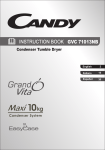
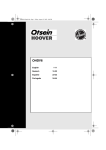
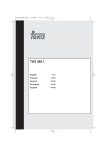
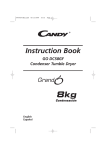
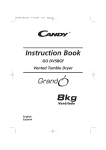
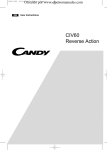
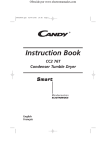
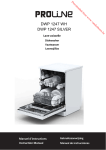
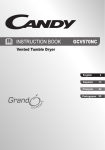
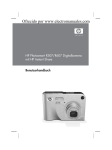
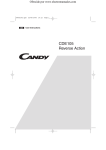
![[EM2517] Owner`s Manual [SP] [FINAL] 20090312](http://vs1.manualzilla.com/store/data/006206989_1-c444341505e19e4251f980d4f9f0eb03-150x150.png)

